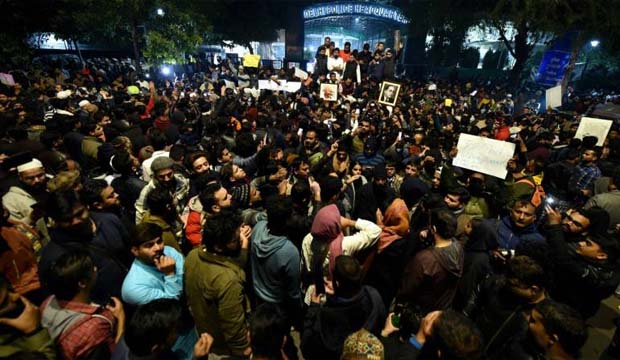ప్రభుత్వాల ప్రజా వ్యతిరేక పరిపాలనకు ఒక సంకేతం ఉద్యమాలు. నరేంద్ర మోడీ ప్రభుత్వ దుష్ పరిపాలనకు ప్రజలు నుండి వ్యతిరేకత నానాటికీ పెరిగి పోతున్నది. ఢిల్లీలో జరిగిన నిరసనలు పరిశీలిస్తే ఈ విషయం స్పష్టమవుతున్నది.2019 డిసెంబర్ 15 వరకు ఢిల్లీలో 12652 ప్రజాందోళనలు జరిగినట్లు పోలీసు రికార్డులు చెబుతున్నాయి. గత ఏడాదితో పోలిస్తే ఇవి 46 శాతం అధికం సిటిజన్షిప్ చట్టం పోరాటాల ని కలుపుకుంటే ఇవి మరిన్ని ఎక్కువ గా లెక్క తేలుతుంది. హిందుస్థాన్ టైమ్స్ కు చెందిన ప్రవేశ లామా రాసిన ప్రత్యేక కథనం గత కొద్ది సంవత్సరాల ఆందోళనలను విశ్లేషించింది.
Protests in national capital hit a new high in 2019, Delhi police’s data shows
 652 demonstrations, dharnas and protest meetings were organised in 2019, a spike of 46% from the 2018 numbers.
652 demonstrations, dharnas and protest meetings were organised in 2019, a spike of 46% from the 2018 numbers.
Prawesh Lama
Students from Jawaharlal Nehru University (JNU) hold placards and raise slogans to protest against the Delhi Police action on the students of Jamia Millia Islamia (JMI) outside Police Headquarters in New Delhi on December 15, 2019.
The national capital was rocked by the highest number of protests in at least eight years in 2019, government data shows, as people ranging from students and job seekers to airline professionals and even policemen, hit the streets of Delhi to air their grievances.
Figures from Delhi Police show 12,652 demonstrations, dharnas and protest meetings were organised in 2019, a spike of 46% from the 2018 numbers. This was the highest since 2011, the earliest year for which data was available. The previous highest number of protests (11,158) was witnessed in 2015.
The 2019 figure is only until December 15 and, therefore, doesn’t include the protests against the Citizenship (Amendment) Act, or CAA, that roiled the city in the last two weeks of December.
Data from the last two weeks of December — which included numerous protests in colleges and campuses against CAA and the start of what is now a month-long sit-in demonstration by women and local residents in north-east Delhi’s Shaheen Bagh — will be included when the figures are updated in early 2020.
A senior Delhi Police official, who asked not to be named, said when data from the anti-CAA protests is included, the number will rise by at least another 500.
To be sure, 2020 has begun on a stormy note with a number of protests and rallies organised against CAA, the National Register of Citizens (NRC), and Jawaharlal Nehru University (JNU) violence, indicating that this year may also witness a large number of protests. The data was compiled by Delhi Police’s special branch — the intelligence wing of the city police — which shares reports with local police.
The trend, experts said, indicates growing dissent and disappointment across sections, but could also be read as a sign of a healthy democracy.
A former senior police officer, who led the state police of Uttar Pradesh and Punjab, too said the increase in protests indicated rising dissent against the establishment. “If it (the spike) was recorded after the CAA protests, it would not have been a surprise. But because the increase is before CAA demonstrations began, it means there is simmering anger among different groups that have a grouse against the establishment. It also shows that people have been emboldened to come out and protest. I see this as a healthy sign in a democracy,” said Prakash Singh, who is considered one of the strongest proponents of police reforms.
Other experts linked the demonstrations to dissatisfaction with government policies. “The protests have been related to economic, social and political issues,” said Sudha Rai, rector (pro-vice chancellor) and professor at the Centre for Political Studies in JNU.
Some prominent demonstrations in Delhi last year include those by employees of the now-grounded Jet Airways, who marched in their uniforms in April after the airline suspended operations, and a protest by constables of Delhi Police against their seniors after violent clashes with lawyers outside the Tis Hazari court last November.
In the last week of November, at least 200 disabled protesters held a round-the-clock sit-in protest at central Delhi’s Mandi House over not being given an opportunity to apply for government jobs.
Data was available from 2011, a year marked by anti-corruption protests that saw tens of thousands of students, young people and professionals join a campaign led by activist Anna Hazare. That year, police recorded 5,354 protests. The next year, Delhi’s streets were swamped by masses of people protesting against the rape and murder of a 23-year-old medical student on December 16. Police numbers show 8,405 protests that year.
The city has been on the boil since December 2019 when Parliament passed CAA, which fast-tracks citizenship for non-Muslim refugees from Bangladesh, Pakistan and Afghanistan. A mob attack inside JNU last Sunday that left 35 people injured has ratcheted up political temperatures and sparked large demonstrations in campuses and on the streets, indicating 2020 may be another torrid year.
Courtesy Hindustan times















